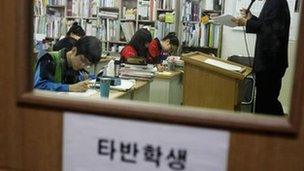What is the key to a successful education system?
- Published

Education Secretary Michael Gove wants to change the primary and secondary school curriculums in England.
He has said he wants pupils to be taught a "core knowledge" of facts and figures. He wants them to be able to recite their times tables, punctuate a sentence correctly and list capitals of the world.
The education systems in Hong Kong, Finland, and South Korea are often lauded as among the best in the world, scoring highly in international league tables.
Here academics suggest reasons why the state-run education system in these countries is top of the class.
Hong Kong
Prof Bob Adamson is head of department of international education and lifelong learning at the Hong Kong Institute of Education:
Emphasis on diligence: It's not natural ability, it's hard work. Hong Kong was built on hard work, as a refugee society. There was no in-built class system and the way to achieve social mobility was through education.
There was no social security blanket, so you were investing in your pension by educating your child. It's called the elderly parent tax.

Parents in Hong Kong often send their children for tutorials
The term "tiger mum" is a little too strong but parents do take a very keen interest in their children's education. They emphasise diligence and will complain if schools don't provide enough homework.
The shadow education system is booming in Hong Kong - some 70% of secondary school-age children have private tuition.
Key exam subjects: There is a curriculum to be followed, a book to be covered and a scheme of work that teachers stick to. It's largely academic. Chinese, maths and English are the core subjects. English classes can amount to a quarter of all weekly classes. Art, music, drama and physical education are usually one or two lessons a week but they get chopped in the run-up to exams.
Everything is strongly orientated towards examinations. There is still the equivalent of the 11-plus here and if you get a good assessment, you will go to a prestigious secondary school.
Pupils are used to working under pressure and working towards examinations. To a large extent the style of teaching is traditional but it is not rote learning without understanding, it is memorisation with understanding.
Pedagogy: There's a mix of academic rigour and structure. There's a theory of learning behind everything. They don't do a project just for the sake of doing it - there's a framework of learning.
Other factors which impact on teaching: One of the big issues in Hong Kong is space. There are 42 kids in each classroom and the only way to organise them is in old-fashioned rows. Teachers often use microphones. They are the gurus and there is little group work or student participation. It is difficult with 42 kids to give them individual attention.
Some school principals have the belief that a silent classroom is a good classroom. The idea that children can learn through discussion has not always permeated through. There have been some moves towards activity-based learning but success has been limited.
Final word: I think the UK government has taken the rhetoric of Hong Kong but not the reality. The devolution of powers to schools is often seen as one of Hong Kong's achievements but the Education Bureau still makes a lot of the decisions.
The context is important. You cannot transpose Hong Kong's style of learning somewhere else without changing the parents, teachers and classroom architecture.
Finland
Prof Kristiina Kumpulainen, Department of Teacher Education, University of Helsinki:
Welfare society: There is an emphasis on supporting every individual, every child regardless of their economic or social background. This basic principle of equality applies to our education system but also healthcare and social care. It's an holistic approach.
We pay for it through taxes and the government tries to support every family.
Highly-qualified teachers: Our teaching profession is highly valued and respected. The programmes are highly competitive and many students do not get a place. We get highly motivated students and the five-year courses are to masters level. Even if you teach at a primary school, you need to have a masters qualification. This is not the same in other Nordic countries.

There is a relaxed atmosphere in Finnish schools
The classroom is a very interactive space where pupils can challenge the teacher. The traditional teacher-directed style is not so typical in Finland.
Local power: Municipalities and schools have a lot of power to localise the national core curriculum. We trust our teachers as they have been selected through a careful process. They are given a lot of freedom and responsibility to tailor learning according to the needs of every child. They are not just paying lip service or following a script.
There are core subjects such as literacy, numeracy and science but we try to achieve a balance in the curriculum. A school day is a mix of core subjects and also art, physical education, woodwork and entrepreneurial education (at secondary level).
The curriculum is being renewed and is due out in 2015. There will be an increase in 21st Century skills, such as collaboration, social interaction, problem solving and life-long learning, but they will not be separate from the core subjects, they will be integrated.
Other factors which impact on teaching: Class sizes are between 15 to 25 across primary and secondary schools. There are no national examinations or rankings. We don't have that culture of comparing schools. If a school is not doing well, it is not closed down. It is given more resources.
Final word: There are elements of the Finnish model which could be implemented elsewhere, such as the emphasis on high quality teachers.
The teaching environment is also important. In relaxed and educationally-supportive environments children are granted authority and accountability in and for learning. We believe that learning and interacting in relaxed educational environments will teach children for life, not for school.
South Korea
Prof Paul Morris, from the Institute of Education, University of London, is a comparative educator who specialises on East Asian education systems:
Connection between exams and the curriculum: The prevalence of testing and examinations has a long history and is embedded in the culture. The curriculum is effectively defined by what is examined. Places come to a standstill on days of public examinations such as the university entrance examination. Traffic is stopped and planes will be diverted to minimise noise.

Asian countries such as South Korea have led the international rankings
The curriculum is dominated by languages, maths and science. English has become a very important element of social mobility.
The high scores on Pisa [held every three years by the Organisation for Economic Co-operation and Development to measure pupils' skills in reading, numeracy and science] probably reflects a strong overlap between the test questions and the exam-driven curriculum that schools focus on, as well as the hard work by the pupils and the strong support/pressure from parents to succeed.
Connection between social mobility and exams: South Korea, and other Far East countries, have a long history of using competitive public examinations as a vehicle for selection and social mobility. It only developed in the West in the 18th Century. Whether you get into a good school or university is wholly dependent on exam results. A child's future, status and social mobility are strongly connected to exam outcomes.
It results in very strong parental support or pressure, depending on how you look at it. When children go home the parents are often on top of them to do their homework. They will also employ private tutors if they can afford it.
Culture of diligence: Children are expected to put the time in. There's a belief that people have differing abilities but everyone can get there - it might just take some a lot longer.
Although the classroom has become more interactive in the last 10 to 20 years, a South Korean lesson would be viewed by people in the UK as didactic, orderly and teacher-led.
Other factors which affect the style of teaching: Education has been strongly harnessed to nation building and instilling a strong sense of national identity. During the '60s and '70s, many of the East Asian countries were driven by the idea that they were still part of an unfinished war - South Korea with North Korea, Taiwan with China - and they used economic growth as a way of competing and ensuring national cohesion and survival.
Final word: The Pisa tests tell only one side of the story. Korean schools can be extremely stressful for children. Surveys tend to suggest that children don't like going to school - they are often stressed and not happy or they're bored.
Schooling is seen to be a process of certification. Questions are being asked as to whether the system is producing the sorts of people the economy and society needs. The system does encourage hard work and diligence but the concerns are that it is unduly stressful, does not promote creativity and the ability to be critical.
- Published7 February 2013
- Published6 February 2013
- Published1 February 2013
- Published25 October 2012
- Published27 November 2012
- Published9 May 2012